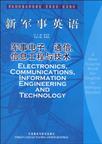新军事英语
2004-1
外语教学与研究出版社
张锦涛 编
236
当今世界,新军事变革的浪潮汹涌澎湃。这是随着人类社会由工业时代走向信息时代,在军事领域中所引发的一场划时代的革命,其规模之大、内涵之新、力度之强、影响之深,是历史上任何一次军事变革都无法比拟的。国际上的经济全球化和政治多极化,使世界战略格局处于重大的调整与力量重组之中。积极迎接世界新军事变革的挑战,努力推进中国特色军事变革的步伐,是建设一支革命化、知识化、现代化军队的根本要求,是当代中国军人的崇高历史责任。 江泽民主席深刻指出:迎接新的军事发展的挑战,关键在人才。在新的军事变革中,高技术武器装备的广泛应用并没有改变人在战争中的地位与作用,相反,它对军人的综合素质,特别是文化素养、智力水平和科技素质,提出了更高的要求。为此,世界各发达国家都十分重视优化官兵的知识结构,提高官兵的综合素质,以更好地适应未来战争的需要。这一客观背景,迫切要求我们紧扣时代的脉搏,加大我军军事教育改革的力度,大力培养和造就高素质的新型军事人才,推进军队和国防现代化建设的发展。 改革开放以来,我国在世界上的影响力不断增大。我们的国防与军队建设,必须适应时代的变迁,加快走向世界的步伐。学习外语,学好外语,是借助语言之桥梁,汲取世界先进文化营养,跟踪世界新军事变革前沿动态,借鉴别国特别是军事强国军队建设经验的一条重要途径。它对于我们开拓视野、增长见识、启迪思维、激发创新,全面提高我军官兵的综合素质,有着不可替代的作用。 在新时期军队建设方针的指引下,我军院校教育中的外语教学在过去的二十多年里取得了长足的进步,结出了丰硕的果实。外语尤其是英语作为我们面向世界的一种交流工具,不仅在日常的对外交往中得到广泛应用,而且在社会、科技、军事、外交等专门领域的国际交流中也发挥着重要作用。外语的通用性与专业性这一客观性质与特点,要求我们面对世界军事知识海洋和信息洪流,在我军院校的外语教学中,坚定不移地走改革创新之路,在坚持掌握语言基础知识、提高外语应用能力的同时,更好地将外语教学与军事知识的学习有机地结合在一起,使我们培养的军事人才在思维层次上,能够更具开放性、国际性和战略性;在外语知识与能力上,能够通专并蓄,体现鲜明的军事特色;在素质结构上,能够更加贴近部队建设的实际需要,适应中国特色军事变革的时代要求。 “军事英语”集外语学习和军事知识为一体,通过英语这一重要的国际化语言载体,学习军事思想、军事科技、军事装备、军事训练等专门知识与信息,培养借助英语满足我军对外借鉴、学习、宣传、交流等实际需要的能力,是我军新时期军事教育的一个重要组成部分。然而,由于军事专业英语教学起步较晚,军事领域所涉专业门类众多,现代军事思想日新月异,军事科技突飞猛进,至今尚无一套选材新、覆盖面广的军事英语系列教材。在总参军训部的指导下,由解放军理工大学、解放军国际关系学院、解放军外国语学院等院校编写的《新军事英语》系列教程,填补了军队院校外语教学上的这一空白,满足了当前军事英语教学的迫切需要。这对于贯彻落实新时期军队院校教学改革的精神,促进院校和部队人才培养质量的提高,无疑是一件十分有意义的工作。 是为序。
当今世界,新军事变革的浪潮汹涌澎湃。这是随着人类社会由工业时代走向信息时代,在军事领域中所引发的一场划时代的革命,其规模之大、内涵之新、力度之强、影响之深,是历史上任何一次军事变革都无法比拟的。国际上的经济全球化和政治多极化,使世界战略格局处于重大的调整与力量重组之中。积极迎接世界新军事变革的挑战,努力推进中国特色军事变革的步伐,是建设一支革命化、知识化、现代化军队的根本要求,是当代中国军人的崇高历史责任。
PartⅠ Military Electronic Engineering and TechnologyLesson 1 Electronic Warfare for the Digitized BattlefieldLesson 2 Electronic Battlefield FacilityLesson 3 Electronic DeceptionLesson 4 ElectronicWardo,Lesson 5 Computer Viruses in Electronic WarfareLesson 6 EW in the ClassroomPart Ⅱ Military Communications Engineering and TechnologyLesson 7 Systems Integration Powers Military Communication EffortsLesson 8 Seamless CommunicationsLesson 9 Joint Tactical Radio SystemLesson 10 A Band for All ReasonsLesson 11 ATM Tactical Network: a Challenge for the Military NetworksLesson 12 Army Vision of Future SATCOM SupportLesson 13 Satellite Communication in Theater Missile DefensePart Ⅲ Military Information Engineering and TechnologyLesson 14 Global Information GridLesson 15 Network-centric Warfare: Its Origin and FutureLesson 16 C4I System Architecture Lesson 17 Information Warfare: Good News and Bad News 3Lesson 18 Tactical Digital Information LinksLesson 19 Tactical Intemet——Key to Digital BattlefieldLesson 20 Computer Security Dilemmas: Differences Between the Pentagon and the Industry ,Appendix One Military TermsAppendix Two Military Acronyms and InitialismsAppendix Three Vocabulary Appendix Four Phonetic Symbols
In order to prepare a session, the scenario manager defines the initial situation and the courseof the session. The EBF supports the scenario manager by providing tools to plan a sessionand to change the situation during the simulated battle. Session preparation consists of selecting thebattlefield environment and setting up environment parameters such as the simulated time of day,course of time and weather conditions; preparing and setting up weapons systems, units and forma-tions; determining which weapons systems and units will be controlled by which (manned or un-manned) simulators; and preparing and storing the objectives, evaluation criteria and material forbriefing and debriefing. Management During the course of a session the scenario manager is supported in three different tasks:Firstly, directing the session, i. e., starting, pausing, recording, fast forward and reverse orgoing back in time to repeat certain parts of the simulation. Secondly, changing the environmentvariables and participating units or weapons systems: the weather conditions can be changed, ob-stacles can be put in position, and units can be moved or assigned a new task or mute. Finally,monitoring and on-line analysis7 are conducted. Radio communication with manned simulators issupported and presentation means are available for monitoring. Analysis The aim of the EBF is to serve as8 a facility for, amongst others, obtaining statements concerningthe suitability of systems and tactics, training concepts, limiting values, validity, etc. In addition toany analyses carried out on-line, further (off-line) analysis of the simulations executed is crucial.
